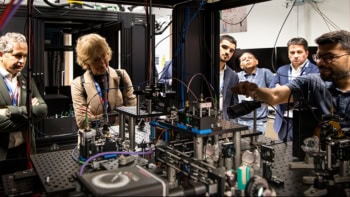Quantum communication on a chip has got one step closer now that US physicists have created a single-photon source compatible with integrated circuits. The source, which is based on a superconducting tunnel junction, could be used to fire microwave photons carrying quantum information from one part of an integrated circuit to another (Nature 449 328).
Microwave communications systems employing so-called quantum cryptography could someday out-perform conventional secure communications, but not before physicists have a practical means of shuttling quantum bits or “qubits” around on chips similar to the ones in present-day computers. Photons are a good choice to carry qubits, but unless they can be emitted singly and reliably on demand there is risk that someone could intercept a surplus photon to furtively steal information.
One way to get a reliable single photon source is to place an atom — the qubit — inside a tiny cavity and excite it to a higher energy state so that it emits a photon containing the mapped qubit state out of the cavity’s opening. But cavities are generally 3D, which makes them difficult to couple to the nearly-2D wires used in integrated circuits. Now, however, Robert Schoelkopf and colleagues from Yale University have solved the problem by making the cavity itself part of a 2D wire and setting inside a superconducting tunnel junction as the qubit instead of an atom.
The junction comprises two grains of aluminium separated by a small insulating barrier. Quantum mechanics allows paired-up electrons to tunnel through the barrier, which means that — like a real atom — the junction has simple energy levels, in this case corresponding to how many electron pairs are on either side of the barrier. By absorbing a microwave photon, an extra electron pair will tunnel to the other side, equivalent to an atom’s excited state. Likewise, the electron pair can tunnel back to a non-excited state by emitting a photon. This means that the existence of a photon at the other end of the wire tells what state the qubit is in.
Unlike classical bits of information, which must take either the value 0 or 1, qubits can also be in a “superposition” of 0 and 1 at the same time. To make the junction work as a qubit, Schoelkopf and colleagues apply a magnetic field to force the junction into an excited state, a non-excited state, or the superposition of both.
Microwaves are regularly used in classical communication, and Schoelkopf and colleagues’ single photon source is a step towards using microwaves in quantum communication. Currently they can get an efficiency of 38% for generating a photon via an excited state and 12% for a superposition, but Schoelkopf told physicsworld.com that the challenge will be to transfer the information from the photon back to the qubit.



